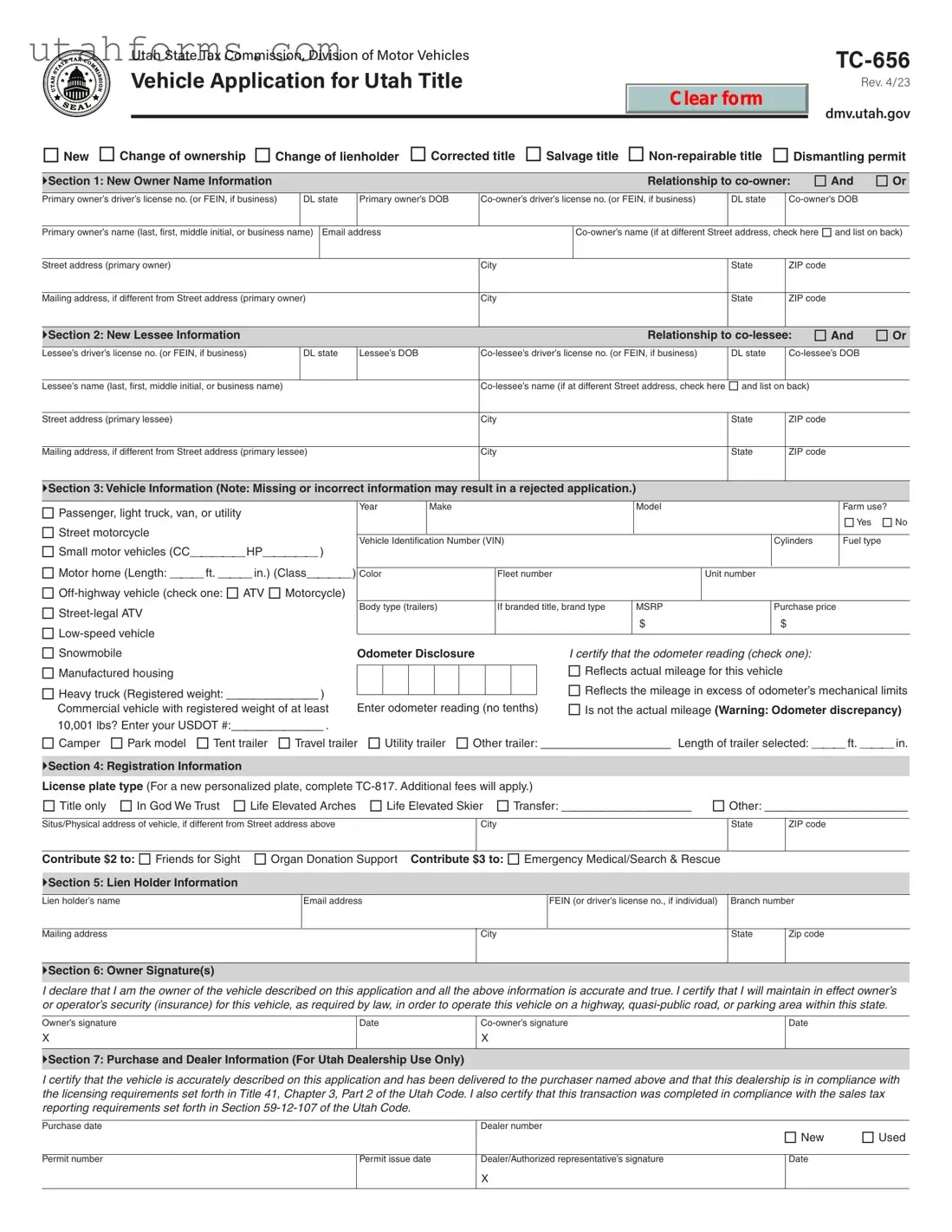The Vehicle Application for Title or Registration (Form REG 343) used in California shares similarities with the Utah DMV TC 656 form, chiefly in its purpose to establish or transfer vehicle ownership. Both forms collect detailed owner information, including names, addresses, and identifying numbers (e.g., driver's license or FEIN for businesses), and require details about the vehicle itself such as make, model, year, and vehicle identification number (VIN). These forms serve as integral documents for ensuring proper vehicle registration and title documentation in their respective states.
Another document resembling the Utah DMV TC 656 form is the Texas Application for Texas Title and/or Registration (Form 130-U). This form, like the TC 656, is vital for individuals looking to either register a new vehicle or transfer ownership in Texas. Sections regarding new owner information, vehicle specifics, and lien holder information are present in both documents. They are designed to ensure all necessary data is captured for the transaction to proceed in accordance with state regulations, emphasizing the importance of accurate and complete submissions for vehicle titling and registration processes.
The Application for Certificate of Title for a Motor Vehicle (Form MV-1) utilized in Pennsylvania also mirrors the Utah DMV TC 656 form in its functionality and data collection. Both forms necessitate new owner information alongside vehicle details, aiming to establish a legal title under the new owner’s name. Key sections include owner identification, vehicle identification number (VIN), and purchase details, which are critical for accurately reflecting the ownership and status of the vehicle in state records.
New York's Vehicle Registration/Title Application (Form MV-82) is analogous to the TC 656 form, focusing on registrants providing comprehensive owner and vehicle information. Each requires the declaration of vehicle type, including designations like passenger, commercial, or off-highway vehicles, and details such as the VIN, year, make, and model. These forms play a pivotal role in the legal acknowledgment of vehicle ownership and the accurate maintenance of vehicle registries within their states.
The Florida Vehicle Identification Number and Odometer Verification (Form HSMV 82042) has a partial overlap with the Utah DMV TC 656 form, particularly in verifying vehicle identification numbers (VINs) and odometer readings. While the Florida form concentrates on these specific verifications to prevent fraud and ensure the integrity of vehicle transactions, both documents are critical in the broader process of vehicle titling and registration, offering safeguards against inaccurate or deceptive information.
Lastly, the Motor Vehicle Title Application (Form TA-VT-04) employed in Vermont shares objectives with the Utah DMV’s TC 656 form. Establishing or modifying vehicle ownership, correcting titles, and dealing with salvage titles are actions facilitated by both documents. They require detailed entries about the vehicle and owner(s), including identification, vehicle specifics, and lien information if applicable, underscoring the forms’ roles in the proper governance and documentation of vehicle ownership transfers.
In conclusion, while each state in the U.S. uses distinct forms for vehicle registration, title applications, and ownership transfers, there’s a clear thread of similarity among them all, including the Utah DMV TC 656 form. Each document is designed to collect comprehensive information ensuring the lawful and accurate documentation of vehicle ownership and status, reflecting the shared aim of safeguarding both consumer and state interests in the realm of vehicle administration.

